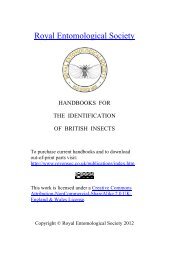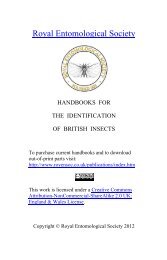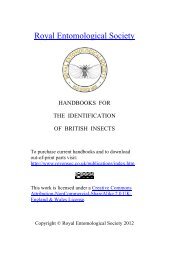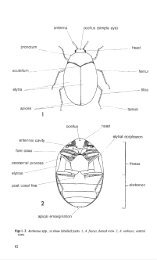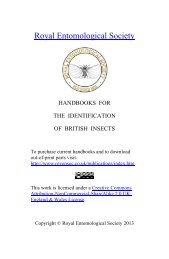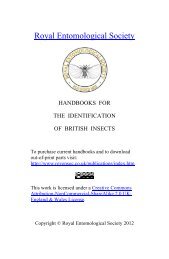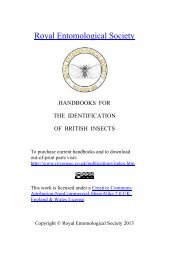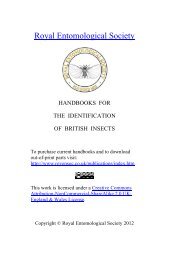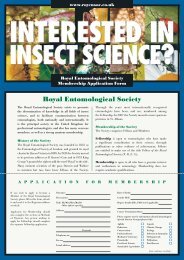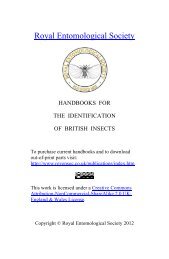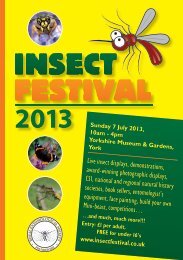Vol 10 Part 14. An introduction to the immature stages of British Flies ...
Vol 10 Part 14. An introduction to the immature stages of British Flies ...
Vol 10 Part 14. An introduction to the immature stages of British Flies ...
Create successful ePaper yourself
Turn your PDF publications into a flip-book with our unique Google optimized e-Paper software.
ll <strong>An</strong>tennae (an) prehensile (adapted for holding or seizing), with long strong apical spines;<br />
without distinct mouth-brushes; thorax and 7th abdominal segment with paired pigmented<br />
air sacs (as). Larvae active, but hold a horizontal position in <strong>the</strong> water betwee n<br />
movements; in still or slow moving water (figs 45-46) . Chaoboridae (p. 39)<br />
<strong>An</strong>tennae not prehensile, without strong apical spines; with distinct mouth-brushes, one on<br />
each side <strong>of</strong> labrum (figs 43-44, br); no pigmented air sacs. Larva active but usually hold<br />
an oblique (fig. 44) (horizontal in <strong>An</strong>opheles fig. 43) position at <strong>the</strong> surface <strong>of</strong> <strong>the</strong> water<br />
between movements; in still or slow moving water (figs 43-44) . Culicidae (p. 39)<br />
12 Body with short tubercles or spinous processes on all segments; anal segment with longer<br />
processes; respira<strong>to</strong>ry system holopneustic with <strong>10</strong> pairs <strong>of</strong> spiracles. Larvae inactive,<br />
characteristically curved in life; usually communal in decaying organic matter, rich soil,<br />
plant roots, dung, etc. (figs 74-78) Bibionidae (p. 47)<br />
Body o<strong>the</strong>rwise; less than <strong>10</strong> pairs <strong>of</strong>spiracles present . 13<br />
13 The two posterior spiracles each on <strong>the</strong> tip <strong>of</strong> a cylindrical process (except Eclaetia fig . lOO).<br />
Larvae usually dark or at least brown or yellow and ra<strong>the</strong>r hairy; very inactive; in dung,<br />
soil or in drier habitats with decaying material, e.g. birds' nests, tree holes (figs 92 ~ <strong>10</strong>0)<br />
Sca<strong>to</strong>psidae (p. 50)<br />
The two posterior spiracles not on such processes 14<br />
14 Last abdominal segment usually with a short non-retractile respira<strong>to</strong>ry tube (figs 30, 32) or<br />
tergites <strong>of</strong> body with numerous distinct transverse sclerotized plates (figs 31 ~ 39) (except<br />
Trichomyia, fig 40); sometimes body with numerous processes. Larvae ra<strong>the</strong>r inactive, in<br />
decaying organic matter in aquatic or semi-aquatic situations (figs 30-40)<br />
Psychodidae (p. 37)<br />
Last abdominal segment without such a tube; abdomen without distinct transverse<br />
sclerotized plates . 15<br />
15 Abdominal segments subdivided superficially in<strong>to</strong> 3 more or less equal parts (fig. 5);<br />
posterior spiracles surrounded by four fleshy lobes (figs 6-8). Larva whitish <strong>to</strong> brownish,<br />
slow moving; in drier dung, soil, or in moist habitats with decaying organic material<br />
(figs 2~ 8) Trichoceridae (p. 35)<br />
Abdominal segments not subdivided superficially in<strong>to</strong> three more or less equal parts . 16<br />
16 Abdominal segments 2-6 divided superficially in<strong>to</strong> two unequal parts (figs 70-71); posterior<br />
spiracles surrounded by 5 reduced lobes (figs 72~73). Larvae slender, active; in moist<br />
habitats where decaying organic material occurs, in deliquescent fungi, or in drier habitats<br />
such as dung, soil, old plant stems, etc. (figs 70-73) . <strong>An</strong>isopodidae (p. 46)<br />
Abdominal segments not so divided; sometimes superficially ringed but in this case <strong>the</strong> rings<br />
are narrow, darker and equal; anal segment without lobes. Larvae usually white with<br />
contrasting darker, <strong>of</strong>ten black head capsule . 17<br />
17 Head capsule ventrally with epicranial plates meeting only at one point (or not meeting,<br />
Diadocidiinae) so that <strong>the</strong> posterior ten<strong>to</strong>rial bridge is absent (fig. 86); or if <strong>the</strong> bridge is<br />
partly formed <strong>the</strong> abdominal creeping welts have sclerotized spicules. Larvae usually<br />
white, sometimes dull yellow <strong>to</strong> bright green; usually in fungi , under bark, in silken webs in<br />
holes in old tree trunks, in soil, decaying plants, roots etc . Myce<strong>to</strong>philidae (p. 47)<br />
Head capsule ventrally meeting at two points, <strong>the</strong> posterior ten<strong>to</strong>rial bridge (ptb) being<br />
complete (figs 87~88) or nearly complete; abdominal creeping welts without sclerotized<br />
spicules. Larvae white with black head capsule; in decaying plant material, animal<br />
excrement, rotten wood attacked by fungus, some in old nests <strong>of</strong> mammals and birds,<br />
sometimes mass movements in large columns . Sciaridae (p. 50)<br />
34




